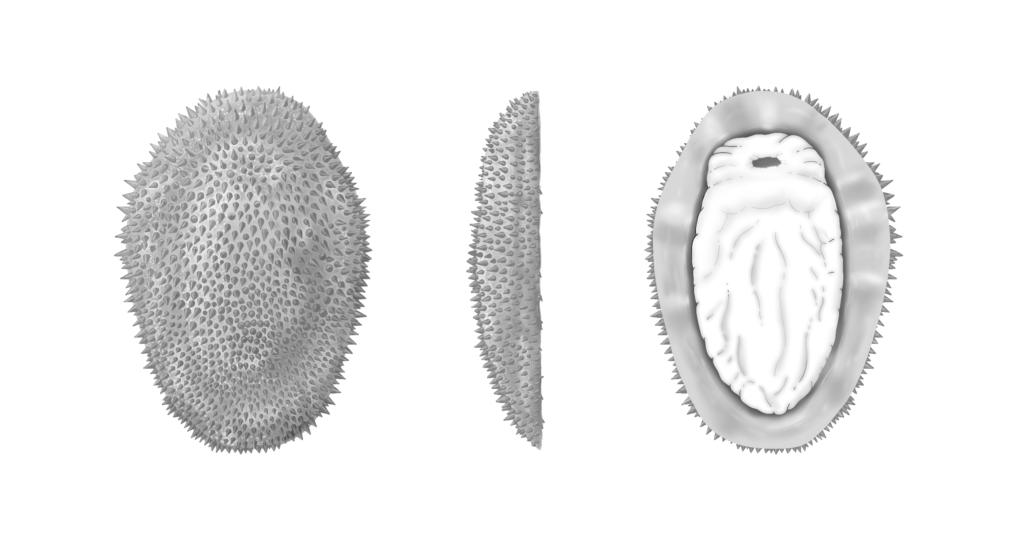Half-a-billion-year-old spiny slug reveals the origins of molluscs

A team of researchers have made an astonishing discovery of a new species of mollusc that lived 500 million years ago.
The new fossil, called Shishania aculeata*, reveals that the most primitive molluscs were flat, shell-less slugs covered in a protective spiny armour. The findings have been published in the journal Science.
The new species was found in exceptionally well-preserved fossils from eastern Yunnan Province in southern China dating from a geological period called the early Cambrian, approximately 514 million years ago.
The specimens of Shishania are only a few centimetres long and are covered in small spikey cones (sclerites) made of chitin, a material also found in the shells of modern crabs, insects and some mushrooms.
Specimens that were preserved upside down show that the bottom of the animal was naked, with a muscular foot like that of a slug – which Shishania would have used to creep around the seafloor.
Unlike most molluscs, Shishania did not have a shell that covered its body, suggesting that it represents a very early stage in molluscan evolution.
Present-day molluscs have a dizzying array of forms, and include snails and clams and even highly intelligent groups such as squids and octopuses.
This diversity of molluscs evolved very rapidly a long time ago, during an event known as the Cambrian Explosion, when all the major groups of animals were rapidly diversifying.
This rapid period of evolutionary change means that few fossils have been left behind that chronicle the early evolution of molluscs.
Corresponding author Associate Professor Luke Parry, Department of Earth Sciences, University of Oxford, said: “Trying to unravel what the common ancestor of animals as different as a squid and oyster looked like is a major challenge for evolutionary biologists and palaeontologists – one that can’t be solved by studying only species alive today.
“Shishania gives us a unique view into a time in mollusc evolution for which we have very few fossils, informing us that the very earliest mollusc ancestors were armoured spiny slugs, prior to the evolution of the shells that we see in modern snails and clams.”
Co-corresponding author Dr Xiaoya Ma, of the Centre for Ecology and Conservation, University of Exeter, and Yunnan Key Laboratory for Palaeobiology, Yunnan University, said: “The specimens were collected from the Guanshan Biota in eastern Yunnan Province, southwestern China, dating back approximately 514 million years.
“This region is renowned for some of the most famous Cambrian Lagerstätten (exceptionally preserved fossil assemblages), including the early Cambrian Chengjiang Biota.
“These fossil assemblages offer unique insights into the early diversification of major animal groups, covering more than 20 phyla and 400 species.
“However, soft-bodied molluscs are exceedingly rare among these early animals, and few taxa were assigned to the Mollusca phylum without controversy.”
Dr Ma continued: “While some Cambrian fossils from this region are visually striking, Shishania might not appear as impressive at first glance, and interpreting its detailed structure was challenging.
“However, by applying a set of advanced imaging and analytical techniques, we were able to uncover the secrets of these ancient animals.
“Reflectance Transformation Imaging (RTI) revealed the layered structures of this flattened mollusc, while X-ray fluorescence (XRF) elemental mapping showed that the cone-shaped spines were of chitinous, organic origin.
“More importantly, the scanning electron microscope imaging identified parallel linear fabric ultrastructures within the sclerite, enabling direct comparison with other animal groups, such as annelids.”
Because the body of Shishania was very soft and made of tissues that don’t typically preserve in the fossil record, the specimens were challenging to study, as many were poorly preserved.
First author Guangxu Zhang, a recent PhD graduate from Yunnan University in China, who discovered the specimens, said: “At first I thought that the fossils, which were only about the size of my thumb, were not noticeable, but I saw under a magnifying glass that they seemed strange, spiny and completely different from any other fossils that I had seen.
“I called it ‘the plastic bag’ initially because it looks like a rotting little plastic bag.
“When I found more of these fossils and analysed them in the lab I realised that it was a mollusc.”

Professor Parry added: “We found microscopic details inside the conical spines covering the body of Shishania that show how they were secreted in life. This sort of information is incredibly rare, even in exceptionally preserved fossils.”
The spines of Shishania show an internal system of canals that are less than a hundredth of a millimetre in diameter.
These features show that the cones were secreted at their base by microvilli, tiny protrusions of cells that increase surface area, such as in our intestines where they aid food absorption.
This method of secreting hard parts is akin to a natural 3D printer, allowing many invertebrate animals to secrete hard parts with huge variation of shape and function from providing defence to facilitating locomotion.
Hard spines and bristles are known in some present-day molluscs (such as chitons), but they are made of the mineral calcium carbonate rather than organic chitin as in Shishania.
Similar organic chitinous bristles are found in more obscure groups of animals (earthworms and their relatives) such as brachiopods and bryozoans, which together with molluscs and annelids form the group Lophotrochozoa.
Professor Parry added: “Shishania tells us that the spines and spicules we see in chitons and aplacophoran molluscs today actually evolved from organic sclerites like those of annelids.
“These animals are very different from one another today and so fossils like Shishania tell us what they looked like deep in the past, soon after they had diverged from common ancestors.”
Co-author Jakob Vinther, at the University of Bristol, said: “Molluscs today are extraordinarily disparate and they diversified very quickly during the Cambrian Explosion, meaning that we struggle to piece together their early evolutionary history.
“We know that the common ancestor of all molluscs alive today would have had a single shell, and so Shishania tells us about a very early time in mollusc evolution before the evolution of a shell.”
*Etymology of Shishania aculeata: Shishan refers to Shishan Zhang, for his outstanding contributions to the study of early Cambrian strata and fossils in eastern Yunnan; aculeata (Latin), having spines, prickly.



